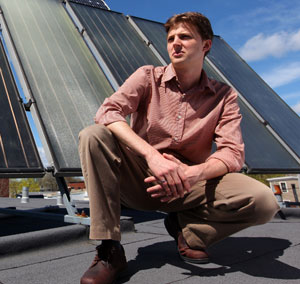 |
| David Oliver studied the economics of green energy technologies, such as wind turbines, solar panels and ground source heat pumps. He poses with solar panels behind him on the roof of the Ecology Action Centre. (Nick Pearce Photo) |
Can renewable energy technology sufficiently supply energy to the average household at comparable costs to non-renewable energy? While not exactly cut and dry, the answer is yes, according to a study from a Dalhousie student.
David Oliver, a second-year combined master of engineering and MBA student recently completed a study under engineering professor Dominic Groulx determining the actual cost of renewable energy technologies. His findings show that renewable sources can be cost-competitive with current non-renewable ones.
“The study had two goals,” says Mr. Oliver. “First to determine the cost of renewable energy for homeowners (based in Nova Scotia) and second to see if economies of scale kick in with larger renewable energy systems. For example, would you save money if you and your neighbours went in on a wind turbine together or if you each put one in your back yard?”
A native of Victoria, B.C., Mr. Oliver looked at four technologies. Ground-source heat pumps (GSHPs) and solar thermal panels were used for space heating and hot water and wind turbines and photovoltaic solar panels were used for electricity. He compared the annual costs of installing and financing these systems with the average annual cost for traditional non-renewable sources.
Ground-source heat pump most economical
“The results are certainly interesting,” says Mr. Oliver. “For a single detached home, the most economical delivery of renewable energy came from a ground-source heat pump with savings between $1,000-$1,800 per year depending on whether you currently use electricity or oil for heating.”
While the total cost of a GSHP can range from $15-$25,000, these energy savings will pay for the system in less than 10 years. The other heating system, solar thermal, delivered water to the home but was slightly more expensive at $245 more per year than the common grid-electricity alternative.
Conversely, both photovoltaic and wind turbine alternatives were not found to be cost-competitive when delivering electricity to the single home. For example, a wind turbine producing enough power for a home would cost roughly $74,000 and a photovoltaic system would take 50 to 60 years to finance.
However, it was on a multi-home scale where wind turbines blew away the competition.
“Once the turbines got to 385 kilowatts, they reached cost parity with grid supplied electricity. As turbines approached the megawatt scale, electricity was delivered to the home for an annual cost hundreds of dollars less than the grid,” explains Mr. Oliver. “The value of wind technology is realized with size; these were the economics of scale we were looking to uncover.”
Interestingly, no cost savings were found when a large GSHP heats a community through a hot water network. Dr. Groulx says the reason for this is that the cost of fitting a community with hot water piping is very expensive.
While the environment was not the motivating factor in this study, Mr. Oliver says it still makes sense to consider the costs.
“There are many compelling reasons to choose renewable systems, but if you're going to invest your money, you should invest in the most economically sensible system, the system which can capture renewable energy from your local environment at the lowest cost.”
So, while you wouldn't completely remove yourself from the energy grid with these systems – electricity when the wind isn't blowing or powering heat pump compressors, you would reduce your carbon footprint. For example, Mr. Oliver determined that powering your home with wind electricity would be the carbon equivalent of removing just over two cars from the road.
Pure economics
Another consideration from the study, as Mr. Oliver notes, is taking into account provincial rebates and grants for installing these systems, which could be subtracted from the costs in his study.
“Public funding programs were omitted from this work, as they can change or end,” says Mr. Oliver. “This analysis examines whether renewable energy technologies can stand on their own two feet against current systems.”
“David's analysis can be used anywhere,” says Dr. Groulx. “The methodology is such that you can apply the figures from any region and get the accurate information for that climate. It paints a clear, unbiased picture of the costs of all energy sources.”
To determine the cost and energy calculations for each system in the study, Mr. Oliver used tools and information from organizations like Statistics Canada, the International Energy Agency (IEA), the Canadian Wind Energy Association (CanWEA) and Natural Resources Canada (NRCan).
